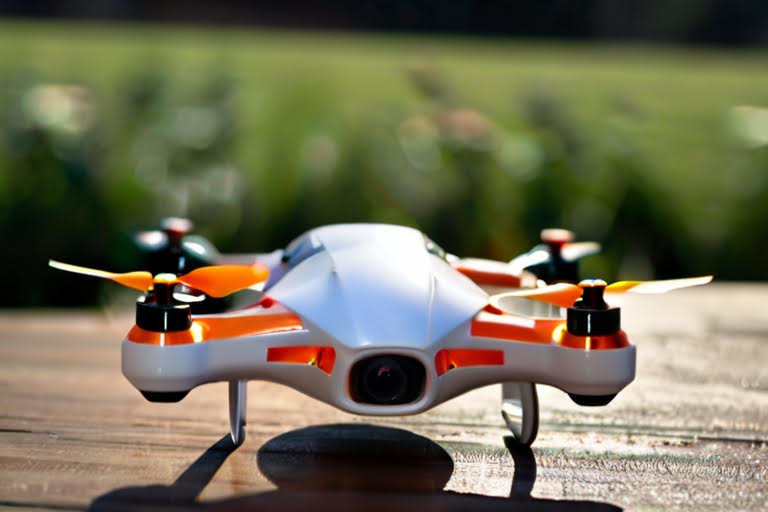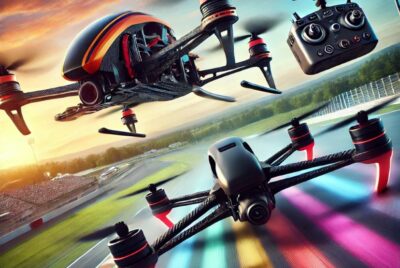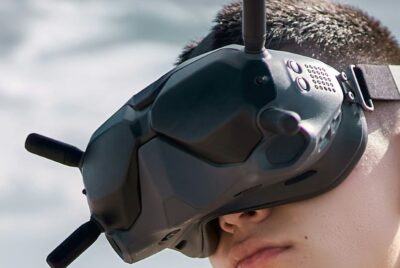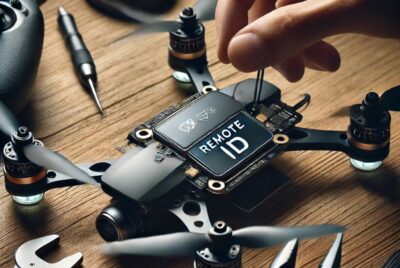FPV Freestyle Drones
Hey there! Some links on this page are affiliate links which means that, if you choose to make a purchase, I may earn a small commission at no extra cost to you. I greatly appreciate your support! Please see our Disclosure to learn more.
Introduction
FPV freestyle drones have revolutionized the way pilots express their creativity and push the boundaries of what’s possible with aerial acrobatics. These agile, high-performance machines are designed to capture stunning video footage while executing mind-blowing tricks and maneuvers. In this comprehensive guide, we’ll explore the world of FPV freestyle drones, from understanding their unique characteristics to choosing the right components and mastering essential flying techniques.
What Sets FPV Freestyle Drones Apart
Agility and Maneuverability
One of the defining features of FPV freestyle drones is their exceptional agility and maneuverability. These drones are built to perform tight turns, rapid ascents, and sudden drops with ease. This allowing pilots to create dynamic, fast-paced video content that captivates audiences.
Durability and Resilience
FPV freestyle drones are designed to withstand the rigors of aggressive flying and the occasional crash. Frames are typically constructed from durable materials like carbon fiber, while components are carefully selected to balance performance and resilience.
Essential Components of an FPV Freestyle Drone
For a more comprehensive look at drone racing components, check out our in-depth article Drone Racing Components – An In-Depth Guide. This detailed guide covers everything from frame selection to motor specifications. It helps both beginners and experienced racers make informed decisions about their drone builds.
Frame
The frame is the backbone of your FPV freestyle drone, providing the structure and support for all other components. Freestyle frames are typically lightweight, durable, and offer plenty of space for mounting cameras, batteries, and other accessories.
Motors and ESCs
High-performance brushless motors and electronic speed controllers (ESCs) are crucial for FPV freestyle drones. These components work together to deliver the power, speed, and responsiveness needed for executing complex maneuvers and stunts.
Flight Controller
The flight controller is the brain of your freestyle drone, processing pilot inputs and controlling the aircraft’s movement. Advanced flight controllers offer features like customizable flight modes, PID tuning, and telemetry. This allows pilots to fine-tune their drone’s performance to suit their flying style.
FPV Camera and Video Transmitter
A high-quality FPV camera and video transmitter are essential for capturing stunning aerial footage. They also provide the pilot with a clear, real-time view from the drone’s perspective. Freestyle pilots often opt for cameras with wide-angle lenses and adjustable settings to achieve the desired look and feel for their videos.
Building Your Own FPV Freestyle Drone
Choosing the Right Components for Your FPV Freestyle Drone
When building your own FPV freestyle drone, it’s essential to choose components that are compatible, reliable, and suited to your skill level and flying style. Research popular frame designs, motors, ESCs, and flight controllers within the freestyle community. Remember, don’t hesitate to ask for advice from experienced pilots.
Assembly and Configuration for Your FPV Freestyle Drone
Assembling your FPV freestyle drone requires patience, attention to detail, and a basic understanding of electronics. Follow online guides and tutorials and take your time to ensure that all components are securely mounted and properly connected. Once assembled, you’ll need to configure your flight controller software, calibrate your ESCs, and set up your FPV system.
Mastering FPV Freestyle Drone Flying Techniques
Basic Maneuvers
Before attempting advanced freestyle tricks, it’s crucial to master basic maneuvers like hovering, banking turns, and figure-eights. Practice these fundamentals in an open, obstacle-free area until you can perform them consistently and confidently.
Acro Mode and Rate Tuning
FPV freestyle drones are typically flown in acro mode, which allows for full manual control of the aircraft’s pitch, roll, and yaw. To achieve the desired responsiveness and control feel, you’ll need to adjust your flight controller’s rate settings, which determine how quickly the drone reacts to stick inputs.
Advanced Tricks and Stunts
Once you’ve mastered the basics, you can start exploring advanced freestyle tricks like flips, rolls, power loops, and matty flips. Break down each trick into its component parts, practice each step separately, and gradually combine them into fluid, seamless maneuvers. Remember, progress takes time and patience, so don’t get discouraged if you don’t nail a trick on your first attempt.
Filming and Editing FPV Freestyle Drone Videos
Camera Settings and Techniques
To capture stunning FPV freestyle footage, experiment with different camera settings like field of view, exposure, and color profile. Practice smooth, deliberate movements and use natural features like trees, buildings, and bridges to create interesting compositions and transitions.
Video Editing and Post-Processing
After capturing your freestyle footage, import it into your favorite video editing software and start crafting your masterpiece. Trim out any dull or shaky segments, and use transitions, effects, and color grading to enhance the visual impact of your shots. Add music that complements the pace and style of your flying, and don’t be afraid to get creative with your edits.
Consumer Drones vs. Racing Drones
While consumer drones are often designed for capturing stunning aerial footage or leisurely flying, racing drones are built with a single purpose: speed and agility. These drones are lightweight, responsive, and made for tight turns and high-speed maneuvers. Unlike consumer drones, which have automated features, racing drones demand precise, manual control, providing a unique and thrilling experience for pilots who crave adrenaline-pumping action!
Top Freestyle Drones for FPV Enthusiasts
Freestyle drone flying is all about agility, creativity, and pushing the limits of what’s possible in the air. For pilots looking to capture those adrenaline-pumping flips, rolls, and twists, having the right drone is crucial. Here, we highlight five of the best freestyle drones on the market, each offering unique features and capabilities that cater to different flying styles and skill levels.
Freestyle Drone #1: iFlight Nazgul 5 V3 HD
The iFlight Nazgul 5 V3 HD is a popular choice among freestyle pilots for its exceptional build quality, performance, and affordability. This 5-inch drone is equipped with durable XING-E Pro motors that provide plenty of thrust and smooth control, perfect for executing complex maneuvers in the air. The frame is designed to be both robust and lightweight, allowing for aggressive flight styles while maintaining resilience against crashes.
Key Features:
- High-Quality Build: Features a durable carbon fiber frame designed to withstand high-impact crashes.
- Optimized Power System: Equipped with iFlight XING-E Pro 2207 1800KV motors and BLHeli_S 45A ESCs for powerful and efficient flight performance.
- FPV System: Includes a high-definition Caddx Vista Nebula Pro camera system for crystal-clear digital video feed.
- Pre-Tuned for Performance: Comes pre-tuned with Betaflight settings optimized for freestyle flying.
- Customizable: Compatible with a wide range of components for easy upgrades and repairs.
Freestyle Drone #2: GEPRC Mark4 HD5
The GEPRC Mark4 HD5 is known for its precision and stability, making it an excellent choice for both intermediate and advanced pilots. This drone is built to be compatible with the DJI Digital FPV system, providing a crisp and clear flight experience. The Mark4 HD5’s 5-inch frame and advanced flight controller setup make it incredibly responsive, allowing pilots to execute tight turns and fast flips with ease.
Key Features:
- DJI HD FPV Compatibility: Comes with a DJI Air Unit or Caddx Vista for HD digital video transmission.
- Robust Frame Design: The carbon fiber frame is both lightweight and sturdy, ensuring durability while keeping the drone agile.
- Powerful Motors: Features GR2306.5 2450KV motors that offer an excellent balance of power and control for freestyle flying.
- Pre-Tuned and Ready: Pre-configured with optimized Betaflight settings for immediate flight performance out of the box.
- Easy Maintenance: Modular design allows for easy repairs and part replacements.
Freestyle Drone #3: DiATONE Roma F5
The DiATONE Roma F5 is a versatile freestyle drone that balances agility with durability. Its 5-inch frame is constructed from premium carbon fiber and features an adjustable camera mount to suit different flying styles and preferences. Known for its solid build and user-friendly design, the Roma F5 offers excellent performance and easy handling, making it a top choice for both freestyle and cinematic flying.
Key Features:
- Adjustable Camera Mount: Compatible with various FPV cameras, allowing pilots to adjust the camera angle to their preference.
- Durable Construction: The carbon fiber frame offers high resistance to impact, making it ideal for freestyle stunts.
- Smooth Flight Experience: Equipped with high-performance Mamba F405 MK2 flight controller and F50PRO ESCs for stable and responsive control.
- Compact Design: Lightweight and portable, making it easy to transport to different flying spots.
- High-Performance Components: Comes with quality motors and ESCs optimized for freestyle maneuvers and tricks.
Freestyle Drone #4: BetaFPV X-Knight 5
The BetaFPV X-Knight 5 is a lightweight yet powerful freestyle drone designed for high-speed maneuvers and tight aerial acrobatics. With its advanced HD digital FPV capabilities, this drone offers an immersive flying experience. The X-Knight 5 is also known for its excellent power-to-weight ratio, which allows for agile movements and rapid accelerations.
Key Features:
- HD Digital FPV: Compatible with DJI FPV Goggles for high-definition video feed and minimal latency.
- Lightweight Frame: Designed for speed and agility, the X-Knight 5 features a lightweight build without sacrificing strength.
- Impressive Power-to-Weight Ratio: Equipped with powerful 2205 2550KV motors for quick acceleration and nimble flight.
- Highly Durable: Reinforced frame ensures long-lasting durability even under challenging flying conditions.
- Versatile Battery Compatibility: Supports 4S and 6S battery configurations, offering flexibility in flight characteristics.
Freestyle Drone #5: Flywoo Explorer LR HD
While the Flywoo Explorer LR HD is often praised for its long-range capabilities, it is also a fantastic option for freestyle flying. Its compact, durable design and high-definition FPV system provide an excellent balance of agility and stability, making it suitable for various freestyle tricks. The drone’s versatility allows pilots to switch from long-range cruising to intense freestyle sessions seamlessly.
Key Features:
- Compact and Portable: Designed to be small and easy to carry, making it ideal for on-the-go pilots.
- DJI HD System Compatibility: Equipped with the DJI Air Unit for high-definition video transmission and low-latency control.
- Durable Frame: Built with a solid carbon fiber frame to withstand crashes and rough landings.
- Versatile Performance: Capable of both long-range flights and tight freestyle maneuvers.
- Efficient Power System: Features an efficient power setup that provides a balance between flight time and performance.
The FPV Freestyle Drone Community
Online Forums and Social Media
The FPV freestyle community is a welcoming, passionate group of pilots who share a love for pushing the boundaries of what’s possible with drones. Engage with fellow enthusiasts on online forums, social media platforms, and video sharing sites. Learn new techniques, get feedback on your videos, and stay up to date with the latest trends and gear.
Freestyle Events and Competitions
Attending FPV freestyle events and competitions is a fantastic way to meet other pilots, showcase your skills, and learn from some of the best in the hobby. From local meetups to international competitions, there are plenty of opportunities to get involved and immerse yourself in the freestyle scene.
Safety and Responsibility for FPV Freestyle Drones
Following Regulations and Guidelines
As with any form of drone flying, it’s crucial to follow local laws and regulations when practicing FPV freestyle. Familiarize yourself with airspace restrictions, register your drone if required, and always prioritize the safety of yourself and others.
Proper Maintenance and Care
Regular maintenance and care are essential for keeping your FPV freestyle drone in top condition and preventing accidents. Inspect your aircraft before and after each flight. Check for loose connections or damaged components, and keep your batteries properly charged and stored. By taking good care of your gear, you’ll ensure that it performs at its best and lasts for many flights to come.
Conclusion
FPV freestyle drones offer a thrilling, creative outlet for pilots looking to push the limits of their flying skills and capture jaw-dropping aerial footage. By understanding the unique characteristics of these drones, selecting the right components, and mastering essential flying techniques, you’ll be well on your way to becoming a freestyle pro. Remember to prioritize safety, engage with the community, and most importantly, have fun!
FAQs
- What’s the best way to get started with FPV freestyle drones?
The best way to get started with FPV freestyle drones is to begin by learning the basics of flying in a simulator, then progressing to a smaller, more durable drone like a tiny whoop or toothpick-style quad. As you gain confidence and skills, you can move on to larger, more powerful freestyle drones. Joining local FPV groups and seeking guidance from experienced pilots can also help you progress and avoid common mistakes. - Can I use my racing drone for freestyle flying?
While racing drones can be used for freestyle flying, they may not be ideal for several reasons. Racing drones are typically optimized for speed and efficiency, with stiffer, less forgiving tuning that can make freestyle maneuvers more challenging. Additionally, racing drones may not have the same level of durability or camera performance as dedicated freestyle builds. However, many pilots do enjoy using racing drones for freestyle, and it ultimately comes down to personal preference and flying style. - How much does a typical FPV freestyle drone cost?
The cost of an FPV freestyle drone can vary widely depending on the components used and whether you build it yourself or purchase a pre-built model. A basic freestyle build can start around $200-300, while high-end, custom-built drones can easily exceed $1000. Keep in mind that you’ll also need to invest in additional equipment like FPV goggles, a radio transmitter, and batteries, which can add to the overall cost of getting started. - What’s the difference between freestyle and cinematic FPV drones?
Freestyle and cinematic FPV drones are both designed for capturing aerial video footage, but they prioritize different aspects of performance. Freestyle drones focus on agility, speed, and the ability to perform acrobatic maneuvers, often resulting in fast-paced, dynamic video content. Cinematic drones, on the other hand, prioritize smooth, stable footage and may sacrifice some agility for better camera performance and longer flight times. Cinematic builds often feature larger propellers, higher-quality cameras, and gimbals for stabilization. - How can I improve my FPV freestyle flying skills?
To improve your FPV freestyle flying skills, start by mastering the fundamentals of flight control, such as hovering, banking turns, and basic maneuvers. Practice regularly in a variety of environments and conditions to build muscle memory and adapt to different challenges. Study video footage from experienced freestyle pilots, and try to break down their techniques and replicate them in your own flying. Participate in online forums and local FPV groups to learn from others and receive constructive feedback on your flying and video editing. Finally, don’t be afraid to push yourself out of your comfort zone and attempt new tricks and maneuvers, as this is how you’ll continue to grow and progress as a freestyle pilot.
Final Thoughts
FPV freestyle drones represent the perfect fusion of art, technology, and skill, allowing pilots to express their creativity and push the boundaries of what’s possible with aerial acrobatics. As you embark on your freestyle journey, remember that progress takes time, dedication, and a willingness to learn from both your successes and failures. Surround yourself with a supportive community of fellow pilots, and don’t be afraid to experiment with different techniques, components, and styles until you find what works best for you.
Above all, remember to prioritize safety and responsibility in all your flying endeavors. By following regulations, maintaining your equipment, and respecting the safety of yourself and others, you’ll help ensure that the FPV freestyle community continues to thrive and grow for years to come.
So, charge up those batteries, strap on your goggles, and get ready to unleash your inner aerial artist. The world of FPV freestyle is waiting for you, and with the right mix of passion, skill, and determination, there’s no limit to the incredible footage you’ll capture and the unforgettable experiences you’ll have along the way.
















